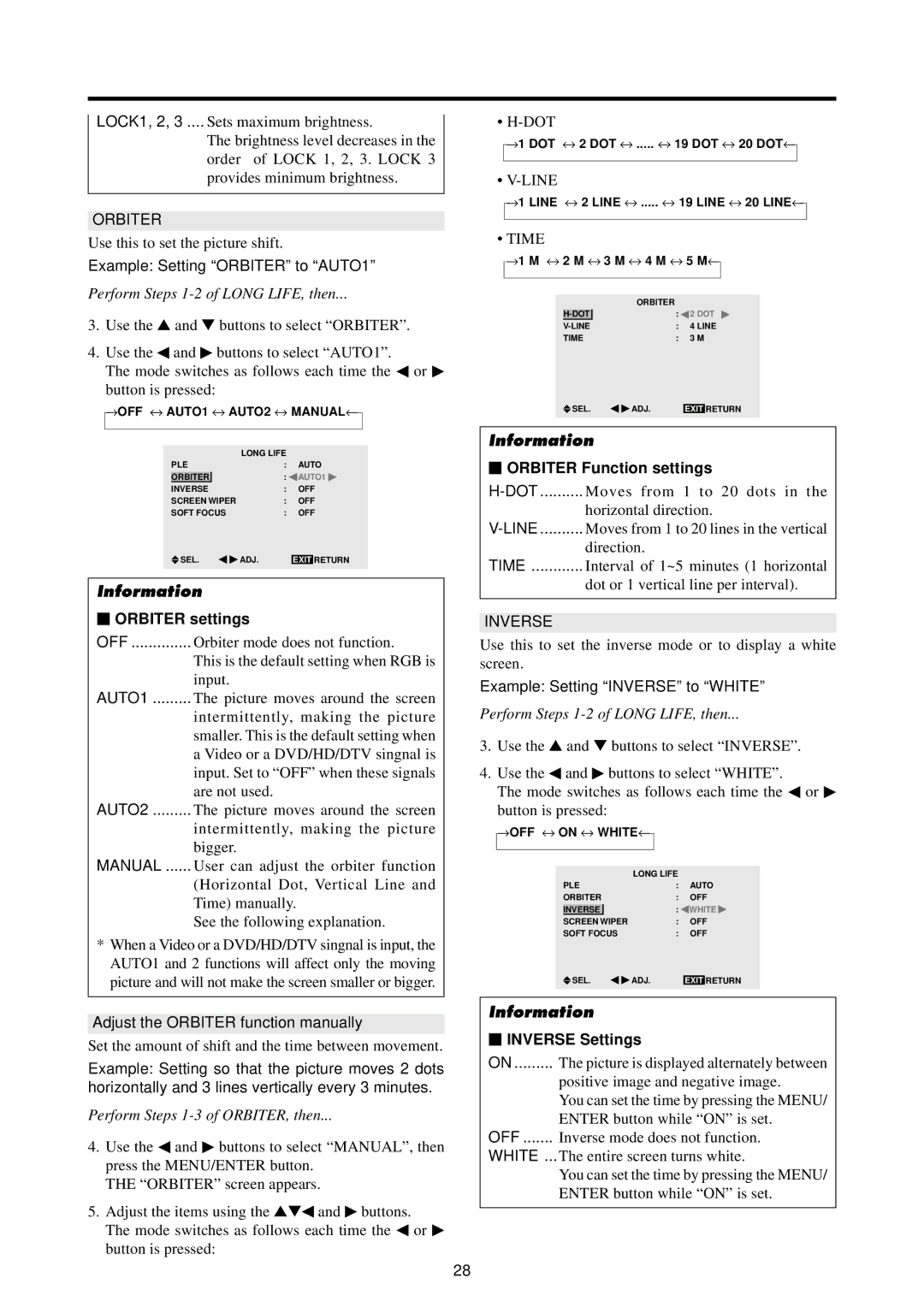
LOCK1, 2, 3 .... Sets maximum brightness.
The brightness level decreases in the order of LOCK 1, 2, 3. LOCK 3 provides minimum brightness.
ORBITER
Use this to set the picture shift.
Example: Setting “ORBITER” to “AUTO1”
Perform Steps 1-2 of LONG LIFE, then...
3.Use the ▲ and ▼ buttons to select “ORBITER”.
4.Use the ◀ and ▶ buttons to select “AUTO1”.
The mode switches as follows each time the ◀ or ▶ button is pressed:
→ OFF ↔ AUTO1 ↔ AUTO2 ↔ MANUAL←
|
|
|
| LONG LIFE |
|
|
PLE | : | AUTO | ||||
| ORBITER |
| : | AUTO1 | ||
|
|
|
|
|
| |
INVERSE | : | OFF | ||||
SCREEN WIPER | : | OFF | ||||
SOFT FOCUS | : | OFF | ||||
|
| SEL. | ADJ. |
| RETURN | |
|
| EXIT | ||||
Information
⬛ORBITER settings
OFF .............. Orbiter mode does not function.
This is the default setting when RGB is input.
AUTO1 ......... The picture moves around the screen
intermittently, making the picture smaller. This is the default setting when a Video or a DVD/HD/DTV singnal is input. Set to “OFF” when these signals are not used.
AUTO2 ......... The picture moves around the screen
intermittently, making the picture bigger.
MANUAL ...... User can adjust the orbiter function
(Horizontal Dot, Vertical Line and Time) manually.
See the following explanation.
*When a Video or a DVD/HD/DTV singnal is input, the AUTO1 and 2 functions will affect only the moving picture and will not make the screen smaller or bigger.
Adjust the ORBITER function manually
Set the amount of shift and the time between movement.
Example: Setting so that the picture moves 2 dots horizontally and 3 lines vertically every 3 minutes.
Perform Steps 1-3 of ORBITER, then...
4.Use the ◀ and ▶ buttons to select “MANUAL”, then press the MENU/ENTER button.
THE “ORBITER” screen appears.
5.Adjust the items using the ▲▼ ◀ and ▶ buttons.
The mode switches as follows each time the ◀ or ▶ button is pressed:
•
→ 1 DOT ↔ 2 DOT ↔ ..... ↔ 19 DOT ↔ 20 DOT←
•
→ 1 LINE ↔ 2 LINE ↔ ..... ↔ 19 LINE ↔ 20 LINE←
• TIME
→ | 1 M ↔ 2 M ↔ 3 M ↔ | 4 M ↔ | 5 M← |
| |||
|
|
|
|
|
|
|
|
|
|
|
|
| ORBITER |
|
|
|
|
|
|
| : | 2 DOT | |
|
|
| |||||
|
|
|
|
|
| ||
| : | 4 LINE | |||||
| TIME | : | 3 M | ||||
SEL. | ADJ. | EXIT | RETURN |
Information
⬛ORBITER Function settings
| Moves from 1 to 20 dots in the |
| horizontal direction. |
Moves from 1 to 20 lines in the vertical | |
| direction. |
TIME | Interval of 1~5 minutes (1 horizontal |
| dot or 1 vertical line per interval). |
INVERSE
Use this to set the inverse mode or to display a white screen.
Example: Setting “INVERSE” to “WHITE”
Perform Steps 1-2 of LONG LIFE, then...
3.Use the ▲ and ▼ buttons to select “INVERSE”.
4.Use the ◀ and ▶ buttons to select “WHITE”.
The mode switches as follows each time the ◀ or ▶ button is pressed:
→ OFF ↔ ON ↔ WHITE←
|
|
|
| LONG LIFE |
|
|
PLE | : | AUTO | ||||
ORBITER | : | OFF | ||||
| INVERSE |
| : | WHITE | ||
|
|
|
|
|
| |
SCREEN WIPER | : | OFF | ||||
SOFT FOCUS | : | OFF | ||||
|
| SEL. | ADJ. |
| RETURN | |
|
| EXIT | ||||
Information
⬛INVERSE Settings
ON ......... The picture is displayed alternately between
positive image and negative image.
You can set the time by pressing the MENU/ ENTER button while “ON” is set.
OFF ....... Inverse mode does not function.
WHITE ... The entire screen turns white.
You can set the time by pressing the MENU/ ENTER button while “ON” is set.
28
